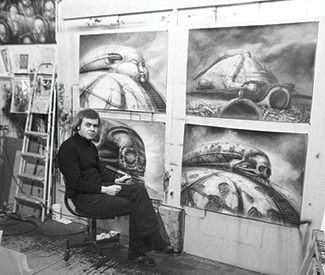FILM It’s so seldom a film of major scale and budget is made without at least some standard commercial aspirations — however misguided — that the rare exceptions seem as curious, improbable, and wonderful as unicorns. (And about as useless, any bottom-line-oriented producer might say.) We’re not talking Heaven’s Gate (1980), Ishtar (1987), or Battlefield Earth
It’s rare enough for an artist to complete one such project. Alejandro Jodorowsky stands nearly alone in having made at least two. A Chilean émigré to Paris, he had avant-garde interests that led him from theater and comic book art to film, making his feature debut with 1968’s Fando y Lis — a low-budget, little-seen harbinger of things to come, based on a play by likeminded Spanish stage and screen surrealist Fernando Arrabal. Undaunted by its poor reception, he created El Topo (1970), a blood-soaked mix of spaghetti western, mysticism, and Buñuellian parabolic grotesquerie with the director playing a messianic lone gunman whose spiritual path requires violent cleanup of a corrupt society. It gradually became the very first “midnight movie” sensation, playing for years to audiences of stoned hippies — no doubt causing some bad trips en route.
After that success, he was given nearly a million dollars to “do what he wanted” with 1973’s The Holy Mountain. It was, essentially, El Topo redux, albeit without the western motifs and with a staggering Pop-Op-surreal pictorialism to its less-Leone-more-Hesse vision quest. He played the Alchemist, a seer-trickster who leads nine representatives of the modern world on a journey to their own souls. It ended with the camera turning on itself and cast turning toward the audience, “breaking the illusion” because “real life awaits us.”
This extraordinary, singular, pretentious, crazy epic was a big hit in Europe. (Rather strangely, it utterly flopped in the US, and its revival was tied up in legal woes for years; before one announced SF screening at the old York Theater, a private collector’s print was seized and impounded.) French producer Michel Seydoux asked Jodorowsky what he’d like to do next. Dune, he said — though as he confesses in Frank Pavich’s fascinating new documentary, he hadn’t actually read Frank Herbert’s cult science-fiction novel yet, though a friend “told [him] it was fantastic.”
In many ways it seemed a perfect match of director and material. Yet Dune would be an enormous undertaking in terms of scale, expense, and technical challenges. What moneymen in their right mind would entrust this flamboyant genius/nut job with it?
They wouldn’t, as it turned out. So doc Jodorowsky’s Dune is the story of “the greatest film never made,” one that’s brain-exploding enough in description alone. But there’s more than description to go on here, since in 1975 the director and his collaborators created a beautifully detailed volume of storyboards and other preproduction minutiae they hoped would lure Hollywood studios aboard this $15 million space phantasmagoria. From this goldmine of material, as well as input from the surviving participants, Pavich is able to reconstruct not just the film’s making and unmaking, but to an extent the film itself — there are animated storyboard sequences here that offer just a partial yet still breathtaking glimpse of what might have been. Intending to create “a cinematographic god … a prophet to change the minds of all the young people in the world,” Jodorowsky’s plans were more fabulously grandiose even than Herbert’s fantasy of galactic war over a planet producing hallucinogenically enlightening “spice.” (The author himself did not appreciate all the director’s ideas.) His cast, to be led by son Brontis (like dad, an eerily ageless interviewee), would include such outsize personalities as Mick Jagger, Orson Welles, Salvador Dali, and David Carradine. Music would be provided in part by Pink Floyd; designers included H.R. Giger, Moebius, and Dan O’Bannon. Not everyone met the filmmaker’s requirements for collaborative “spiritual warriors” — Douglas Trumbull, the FX wizard for 2001: A Space Odyssey (1968), was rejected for being all business.
As the documentary details, this dazzling package did indeed impress the Hollywood suits needed to complete its financing. They had just one quibble: Jodorowsky. It was his vision, but he was too much of a wild card for a commercial gamble of this scale.
Finally, bitter defeat was admitted. Screen rights were later acquired by Dino De Laurentiis’ company. Hired after numerous other directors jumped ship, David Lynch still considers 1984’s Dune his worst, most creatively compromised film. (Thirty years later it’s still awful, despite some stubborn defenders.) Jodorowsky, who admires Lynch, admits he was perversely relieved at how abysmally that costly flop turned out.
His own filmic career took a hard hit from which it never really recovered. 1980’s Tusk and 1990’s The Rainbow Thief were incongruous, barely-seen, half-hearted stabs at the mainstream; 1989’s Santa Sangre a welcome return to form, yet it also a somewhat pale imitation of earlier work. (His forthcoming first feature since, The Dance of Reality, has elicited similar responses.) He busied himself in other projects, notably writing fantasy comics. His Dune became a mostly forgotten industry tale — ah, the Seventies, when they were that crazy. (But not that crazy, alas.)
Yet the incredible storyboard tome got circulated around. As vividly suggested here via clips, its influence is unacknowledged yet hard to deny in umpteen subsequent movies and other media, from the Star Wars and Alien films to recent releases. As the now 85-year-old Jodorowsky serenely observes, “[My] Dune is in the world like a dream. But dreams change the world, also.” *
JODOROWSKY’S DUNE opens Fri/28 in San Francisco.

